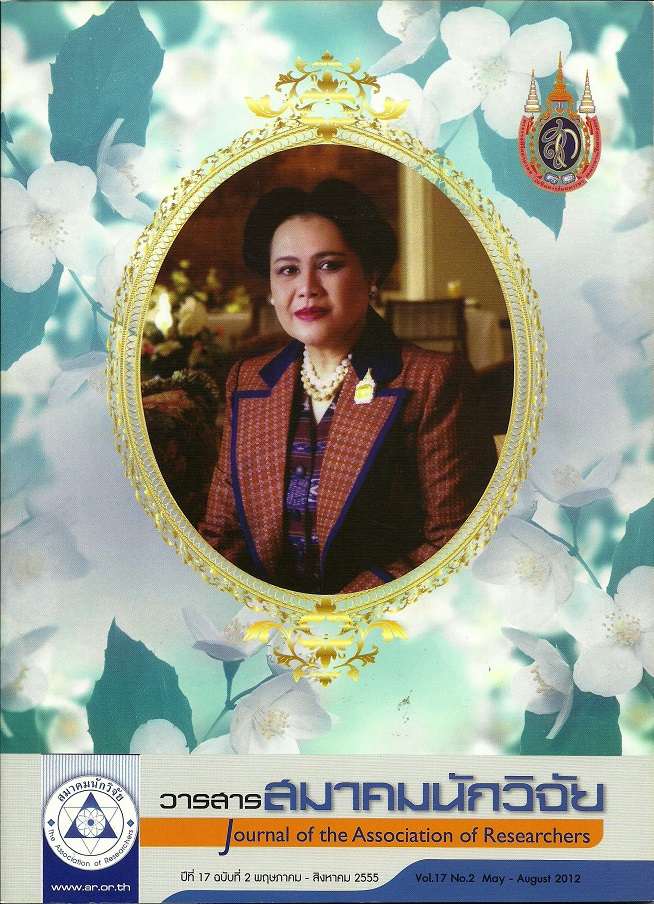MARKETING STRATEGY MODEL OF EUROPEAN PASSENGER CARS FOR THAILAND AUTOMOBILE MARKET
Main Article Content
Abstract
This research is a mixed research method using both qualitative and quantitative research methodology. The research aims to (1) analyze the strength, weakness, opportunity, and threat of the marketing strategies of eight European passenger car companies in Thailand, (2) analyze the components of the latent variables of psychological factors, the marketing factors, and the key performance indicators, (3) analyze the direct and indirect effects among the psychological factors, the marketing strategies, and the key performance indicators, and (4) formulate an effective marketing strategy model for European passenger car companies in Thailand.
The qualitative data were collected by conducting in-depth interviews of twelve Chief Operation Officers of eight European passenger car companies. The quantitative data were collected by questionnaires from 699 samples of European passenger car owners. The statistics used were descriptive and inferential statistical analysis of, mean, standard deviation, confirmatory factor analysis, and path analysis was used to test the hypotheses. Structural equation modeling was used to test the model.
The qualitative findings revealed that (1) strengths were image and products, weaknesses were distribution channel, opportunities were exchange rate and economic rebound, threats are politics and grey import. The quantitative findings revealed that, the components of the latent variables (2) psychological factors consisted of learning, perception, motivation, personality, and attitude. (3) Marketing mix factors were place, price, product, promotion, and customer relationship management. (4) The operational achievements were satisfaction, referral, repeat purchase, and company and brand image. (5) Factors affecting on achievement and marketing factors both had positive effects on the key performance indicators, and all hypotheses were supported. (6) The constructural model corresponded with the empirical data of all the variables (GFI = 0.99, AGFI = 0.97, Chi-Square = 53.99, df = 35, RMSEA = 0.028).
Article Details
บทความที่ปรากฏในวารสารนี้ เป็นความรับผิดชอบของผู้เขียน ซึ่งสมาคมนักวิจัยไม่จำเป็นต้องเห็นด้วยเสมอไป การนำเสนอผลงานวิจัยและบทความในวารสารนี้ไปเผยแพร่สามารถกระทำได้ โดยระบุแหล่งอ้างอิงจาก "วารสารสมาคมนักวิจัย"
References
Canada.
Grein, A. F., Craig, C. S. & Takada, H. (2001). Integration and Responsiveness: Marketing Strategies of Japanese and European Automobile Manufacturers. Journal of International Marketing, 9(2), 19-50
Hanley, M. (2009). Automotive Market in Thailand: Industry Overview. Retrieved Jan 29, 2009, from www.ey.com.
Hawkins, D. & Mothersbaugh, D. L. (2010). Consumer Behavior: Building Marketing Strategy. (11th ed.). New York:
McGraw Hill. Ismail, S. T. & Alsadi, B. Y. (2010). Relationship Marketing and Organizational Performance Indicators. European Journal of Social Sciences, 12(4), 545-557.
Jasfar, F. (2001). Mediating effects of consumer trust, consumer commitment, and customer satisfaction, in buyer-seller relationships: An investigation of automobile service centers in Indonesia. D.B.A. Nova Southeastern University.
The USA. Kotler, P. (1999). Marketing Management: The Millenium Edition. New Delhi: Prentice-Hall.
Kotler, P., & Keller, K. L. (2006). Marketing Management (12 ed.). New Jersey: Prentice-Hall.
Lee, J. W. (2009). Relationship between consumer personality and brand personality as self-concept: From the case of Korean automobile brands. Academy of Marketing Studies Journal. 13, 25-43.
Narashimhan, S. (1987). A causal model of external search for information for durables: A particular investigation in the case of new automobiles. Ph.D. The State University of New York.
The USA. Nooh, S. (1997). The impact of the perception of marketing mix variables on international product choice: The Malaysian perspective. D.B.A. Nova Southeastern University.
The USA. Oica. (2010). International Organization of Motor Vehicle Manufacturers: Economic Facts. Retrieved May 6th, 2010, from, www.oica.net.
Panjakajornsak, V. (2010). A Study of Purchasing Decisions and Business Performance of firms in Thailand's Automotive industry. Graduate School, Eastern Asia University.
Ramsey, R. P., & Sohi, R. S. (1997). Listening to Your Customers: The Impact of Perceived Salesperson Listening Behavior on Relationship Outcomes. Academy of Marketing Science Journal. 25(2), 127-137.
Rosecky, R. B., & King, A.B. (1996). Perceptual differences among owners of luxury cars: Strategic marketing implications. The Mid-Atlantic Journal of Business, 32(3), 221-240.
Schiffman, L. G., & Kanuk, L. L. (1997). Consumer Behavior. (6hed.). New Jersey: Prentice-Hall.
Tanmay, C., Shradha, S., & Krishnan, M. (2009). Determinants of brand equity-A blueprint for building a strong brand: A study of automobile segment in India.African Journal of Marketing Management, 1(4), 109-121.
Thanasuta, K., Patoomsuwan, T., Chaimahawong, V. & Chiaravutthi, Y. (2009). Brand and Country of Origin Valuations of Automobiles. Asia Pacific Journal of Marketing and Logistics. 21, 355-375.
Yoon, S. J. & Kim, J. H. (2000). Empirical validation of a loyalty model based on expectation disconfirmation. The Journal of Consumer Marketing, 17(2), 120-133


